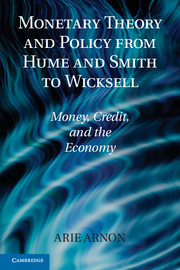Book contents
- Frontmatter
- Dedication
- Contents
- List of Illustrations
- List of Tables
- Preface
- Introduction
- Part one Analytical and Historical Foundations
- 1 Monetary Theory circa 1750David Hume
- 2 Mid-Eighteenth-Century British Financial System
- 3 Adam SmithThe Case for Laissez-Faire in Money and Banking
- 4 “Monetary Theories of Credit” in Exchange
- Part two Debating Monetary Theory under Inconvertibility
- Part three Debating
- Part four The Road to Defensive Central Banking
- Part five A New Beginning
- Bibliography
- Author Index
- Subject Index
2 - Mid-Eighteenth-Century British Financial System
Published online by Cambridge University Press: 05 July 2014
- Frontmatter
- Dedication
- Contents
- List of Illustrations
- List of Tables
- Preface
- Introduction
- Part one Analytical and Historical Foundations
- 1 Monetary Theory circa 1750David Hume
- 2 Mid-Eighteenth-Century British Financial System
- 3 Adam SmithThe Case for Laissez-Faire in Money and Banking
- 4 “Monetary Theories of Credit” in Exchange
- Part two Debating Monetary Theory under Inconvertibility
- Part three Debating
- Part four The Road to Defensive Central Banking
- Part five A New Beginning
- Bibliography
- Author Index
- Subject Index
Summary
David Hume’s monetary analysis described in Chapter 1 relates to the British financial system, but is of a general and abstract nature. In this chapter, we will present a brief overview of the British financial system in the mid-eighteenth century that will prepare the ground for the discussion of Adam Smith’s monetary thinking in Chapter 3. The financial system in the United Kingdom was an important and intriguing feature of the fascinating British economic story known throughout the world in later years as the Industrial Revolution. One cannot fully understand the Industrial Revolution without considering its links with British finance. More important in the present context, it will be impossible to assess Smith without first describing the financial system.
The British financial system was unique in performing two functions: providing payments services that facilitated a relatively efficient exchange process and contributing to an impressive rise of social intermediation. Hume and, as we shall see, Smith well understood the importance of transforming a barter economy into a monetary one as well as the role of payments services in this process. Intermediation, a more advanced function of the financial system that is not necessarily related to payments services, makes it possible not only to match buyers and sellers with ease, but also to bring surplus economic units together with those who are currently short of funds. In other words, the financial system enables transactions in which financial assets rather than commodities are exchanged (we will elaborate further on these two functions in Chapters 4 and 9).
- Type
- Chapter
- Information
- Monetary Theory and Policy from Hume and Smith to WicksellMoney, Credit, and the Economy, pp. 26 - 32Publisher: Cambridge University PressPrint publication year: 2010

